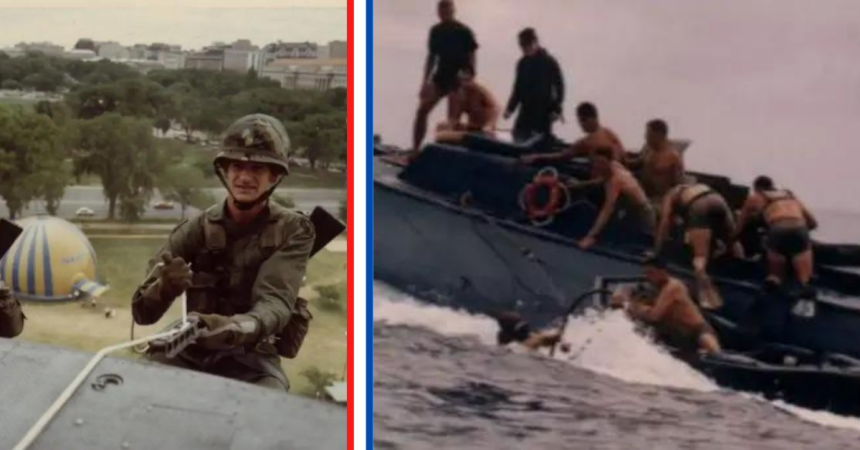Atlantic convoy operations could be terrifying for any Merchant Mariners and Navy sailors assigned to cross the treacherous waters, but the desperation of SC 107 in 1942 is on a whole other order of magnitude. The 42 ships were spotted Oct. 30, 1942, and spent the next week struggling to survive as half their number were consumed by 16 U-boats.

The HMS Edinburgh survives extreme torpedo damage from a German sub attack.
(Imperial War Museum)
SC 107 was filled with ships sailing from the Canadian city of Sydney in Nova Scotia to the United Kingdom. It was a slow convoy, filled with ships thought capable of sustaining 7 knots but incapable of holding the 9 knots of faster convoys on the same route.
These would normally be heavily guarded, but Canada and America had shifted as many ships as possible to North Africa to support landings there. So the convoy was lightly guarded with just a destroyer and three corvettes assigned to travel all the way across with it. On October 30, U-boat pack Violet, Veilchen, spotted the juicy, underdefended target.
The pack was deployed in a patrol line with 13 boats ready for combat, and those boats were able to summon three more that would join the hunt from the west. These 16 German combatants prepared to slaughter their way through the Allied convoy.

Allied bombers helped sink two German U-boats at the start of the fight over SC 107, but the convoy soon moved out of their range.
(U.S. Air Force)
The German radio traffic tipped off the convoy that it was about to come under attack, and its escort deployed to protect it. Luckily, this first contact came within range of the Western Local Escort, ships assigned to protect convoys near the Canadian and American coasts as the convoys were still forming and starting east.
So the thin escort was buttressed by the British destroyer HMS Walker and Canadian destroyer HMS Columbia. This made for three destroyers and a few smaller escorts. They worked together with land-based planes and bombers to smack the submarines down, hard. Two German U-boats were sunk, and another sub attack was interrupted. On October 31, two submarines were driven off.
But, by November 1, the Western Local ships were at the edge of their range and had to turn back. The convoy was, so far, unharmed. But it was 42 ships protected by only five ships, only one of which was a destroyer. And 13 German boats were out for blood.

German submarines were equipped with deck guns that allowed them to slaughter undefended convoys, but they used their massive torpedoes to kill convoys when surface combatants were in the water.
(Imperial War Museums)
The escorts spent the first hours performing desperate passes around the convoy to keep the U-boats at bay, but after midnight the subs made their move. They attacked the escort ships. One U-boat made it past the escorts and hit a ship with a torpedo. First blood opened the floodgates. After the first ship was finished off, another seven were hit and destroyed by simultaneous attacks from multiple U-boats.
Four submarines succeeded in sinking enemy ships that first night, and three others had taken shots. The next day, November 2, a new escort corvette joined the convoy, but it couldn’t stop the sinking of a ninth convoy ship. Another destroyer was added to the bleeding convoy.
On November 3, 10 submarines made attempted attacks, resulting in the sinking of one tanker. As night fell, the subs hit four more ships and sank them, including the “commodore ship,” where the top merchant mariner of the fleet sailed and commanded.

The USS Schenck was one of the destroyers sent to protect SC 107 from further attacks on November 4.
(U.S. Navy)
One of the ships hit was a large ammo ship filled with munitions. Approximately 30 minutes after it was attacked, the fires resulted in a massive explosion that shook the waters, damaged nearby ships, and likely sank the German boat U-132.
Now near Iceland, ships laden with rescued survivors broke north for Iceland to disembark those still alive while the rest of the convoy continued east. The U.S. Navy dispatched two destroyers to guard the convoy, but SC 107 would lose one more ship in the closing hours of November 4.
The next day, November 5, the convoy reached the range of anti-submarine planes and those, combined with the increased naval escort, finally drove off the German vessels. But 15 ships were already sunk and more damaged. Even counting the probable loss of U-132, Germany sacrificed three submarines in this pursuit.
The tables were, slowly, shifting in the Atlantic, though. The technological and industrial might of the U.S. was allowing more and more vessels to hit the waters with radar and sonar that would find the U-boats wherever they hid. Six months after SC 107, the naval clashes of Black May would signal the fall of the wolfpacks.


























